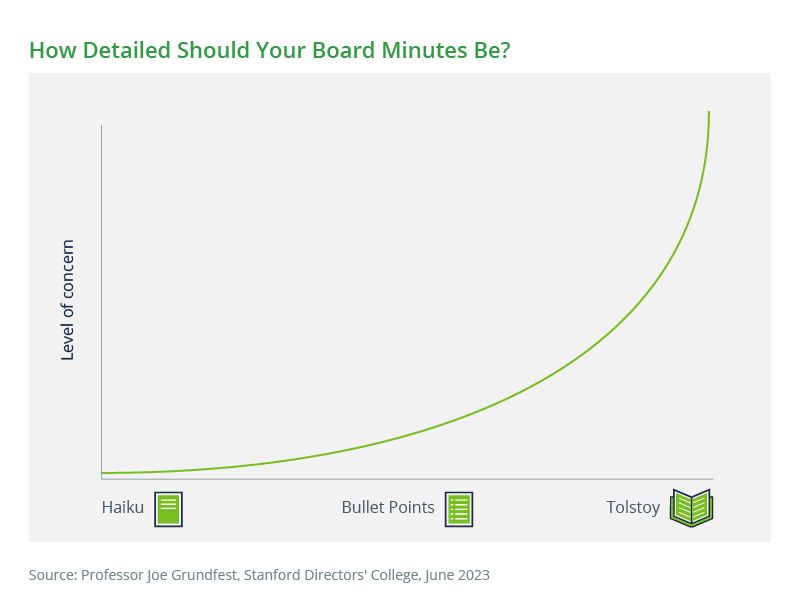Blog
How to Review Committee and Board Minutes: A Guide for Directors
| In addition to being an important part of a company’s internal record-keeping process, board and committee meeting minutes can be critical in helping mitigate litigation risk for directors. In this week’s D&O Notebook, my colleague Lenin Lopez offers several insights and strategies for directors when reviewing board and committee minutes. – Priya Huskins |
Board and committee meeting minutes are an important part of a company’s internal record-keeping process. They function as the official record of discussions, decisions, and actions taken during those meetings. They are also critical in helping mitigate litigation risk for directors.
For directors named in derivative lawsuits alleging a breach of fiduciary duty to shareholders, you know that one of the first hands played by plaintiffs’ attorneys was a request to inspect the company’s books and records. Books and records include, among other things, committee and board minutes. Good minute-keeping practices can help prevent lawsuits from being filed and can garner faster ends to filed suits. Poor minute-keeping practices can lead to a broad discovery process that may involve the review of your business and personal notes, emails, and texts.

Consequently, it is important for directors to take special care when reviewing board and committee minutes before they are ultimately approved and made a part of the company’s internal records.
8 Factors to Consider When Reviewing Committee and Board Minutes
The following are a few points for directors to keep in mind in their reviews.
1. Reviewing and Approving Meeting Minutes Promptly
Companies should maintain a process whereby directors receive drafts of meeting minutes in advance of the next board or committee meeting. This will allow you to review drafts while meeting discussions and decisions are still fresh in your mind, thus avoiding omissions and inaccuracies. In addition, it will bolster the proposition that the company follows good minute-keeping practices, such that there isn't necessarily a need to look beyond the minutes to understand what transpired during the meeting.
A Delaware case involving Netsmart Technologies provides a great example of what not to do in terms of minute-keeping practices. The case describes a set of facts involving an announced merger by Netsmart. Following Netsmart’s announcement, several lawsuits were filed to halt the merger. Shortly thereafter, the board committee that approved the merger approved minutes for 10 meetings spanning three months. In its decision granting a preliminary injunction, in part, the court noted that “tardy, omnibus consideration of meeting minutes is, to state the obvious, not confidence-inspiring.” It is easy to envision a court characterizing even the most robust and well-crafted board and committee minutes as “not confidence-inspiring” if they are not drafted, reviewed, and approved promptly after the meeting. Plaintiffs’ attorneys are sure to have a similar view and may leverage the prolonged delay in approving minutes as a basis to push for a broadened discovery process.
2. Using Agendas, Pre-read Materials, and Notes
Agendas, pre-read materials, and notes are excellent to use as references when reviewing drafts of board and committee minutes. These documents can help verify the accuracy and completeness of the information contained in minutes.
Personal notes kept by directors have become an area of concern because they can be used against directors in the context of litigation. What a director considers to be a benign note reflecting a harmless initial impression, colorful commentary, or a doodle has the potential to become a discoverable part of the corporate record. In litigation, these types of notes are routinely subpoenaed. You want to avoid a situation where you are required to explain the rationale for any of your notes, especially those that were intended to be humorous. See this article for good note-taking practices for directors.
Lastly, inquire if your company maintains a document or record retention policy that extends to directors’ notes.
3. Comparing Committee Minutes with Board Minutes
When reviewing committee minutes, directors should review corresponding board minutes to ensure that significant issues discussed at the committee level and reported to the full board are appropriately captured. For example, if a company’s audit committee is delegated oversight of cyber-related risks, the audit committee discusses a significant cyber-related risk at a committee meeting, and then reports those discussions to the full board, there should be a reference to that within the board minutes. This holistic approach to reviewing committee and board minutes should help identify areas where drafts of minutes need to be enhanced or refined. In the end, it is best if board and committee minutes can be read together without information gaps. The alternative is having to explain disconnects in the context of litigation or a regulatory investigation.
4. Appropriately Referencing Information Relied Upon
Minutes should clearly reference any pre-read materials, reports, and/or data relied upon as part of board and committee discussions. For example, if the board has considered key developments or trends contained in a particular report in connection with the approval of resolutions, that report should be referenced in the minutes. This practice will help reinforce the fact that directors are exercising their fiduciary duties through informed decision-making. From a litigation perspective, this practice can help establish a defensible record of director diligence and reliance on facts that influenced board and committee decisions. See this article for a refresher on the fiduciary duties of board members.
5. Referencing External Consultants, Lawyers, or Subject Matter Experts
When external consultants, lawyers, or subject matter experts participate in board or committee meetings, reference their role in the meeting and their contributions within the minutes. The rationale for doing this is like the one noted above—it will help reinforce that directors are exercising their fiduciary duties by taking steps to inform their decisions.
6. Denoting Privileged Discussions
Minutes should appropriately capture when the board and committees are engaged in privileged discussions with counsel. To protect privileged discussions, it may be advisable for the minutes to take the form of a summary of the general topic(s) discussed. However, there may be instances where counsel advises that the record would be better served to expand the discussion in the minutes and rely on redacting privileged information in connection with a books and records request. When the company’s general counsel or other in-house counsel is leading the privileged discussions, a good practice is to separate sections within minutes to specifically describe the discussions as privileged. While this area is nuanced and something that company counsel will undoubtedly painstakingly look to address as part of the drafting process, directors should be attuned to the importance of denoting when discussions are privileged within their review.
7. Addressing Conflicts of Interest and Dissent
Minutes should capture the existence of director conflicts of interest in the context of board and committee discussions and decisions, as well as how the board and/or committee addressed the issue. Failing to do so can call into question the integrity of the board, as well as any decisions that were made. Instances where conflicts of interest were not appropriately managed—whether through abstentions, recusals, or forming a special committee—tend to become fertile ground for litigation and/or regulatory action.
How should director dissent be documented? The easy cases are when a director requests that their dissent get referenced within the final minutes. In practice, directors will typically make this request in the meeting. The motivation will likely be a desire to put something in the corporate record that distances them from a particular discussion and/or decision that they have reservations about. This is different from when a director raises concerns and asks probing questions before ultimately agreeing with the other directors. Even the liveliest of board or committee meetings can generally be accurately documented by including the following descriptor in company minutes: “…members of the board asked questions, and a discussion ensued.”
8. Generally Avoiding Lengthy Minutes
How detailed should board and committee minutes be? Stanford Law School Professor Joe Grundfest uses a handy framework to answer the question—one where length and detail of minutes correlate to a heightened risk of litigation exposure. The graphic below is used with his permission.

In general, minutes shouldn’t equate to transcripts of board and committee meetings. Rather, they should clearly reflect when the board and committees have dedicated substantial time to discussing issues, especially when significant to the company, like equity financings, merger & acquisition activity, and restructurings. Agendas can play a role by reflecting the amount of time reserved to discuss matters. When the meeting minutes track to the agenda, they can reinforce the proposition that the board dedicated substantial time discussing a particular issue. Ultimately, minutes, and sometimes associated resolutions, should provide sufficient detail and context to show that the directors faithfully exercised their fiduciary duties.
9. Provide Feedback on Structure and Format of Committee and Board Minutes
While there isn’t a universally accepted structure or format for board and committee minutes, each company should generally develop and follow a standard appliable to their board and committees. Beyond uncontroversial items, like meeting date, location, and list of attendees, directors should ensure that meeting minutes capture discussions, decisions, requests, and other action items clearly and concisely.
Directors should also collaborate closely with those responsible for drafting the minutes, typically the corporate secretary, to address any concerns. Remember, practices in structure and format of minutes vary, and case law continues to provide insights into how courts and plaintiffs’ attorneys evaluate minutes. With that in mind, the structure and format of minutes should be viewed by directors and those responsible for drafting the minutes as an area to continuously improve upon.
Final Thoughts
The rules of the road regarding how directors should consider approaching their reviews aren’t typically part of the proverbial director handbook. With the benefit of the practice points shared in this article, directors should be in a better position the next time they review drafts of board and committee minutes.
Author
Table of Contents











